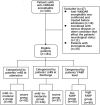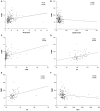Fibrinogen-to-albumin ratio percentage: An independent predictor of disease severity and prognosis in anti-N-methyl-D-aspartate receptor encephalitis
- PMID: 36908596
- PMCID: PMC9998915
- DOI: 10.3389/fneur.2023.1083752
Fibrinogen-to-albumin ratio percentage: An independent predictor of disease severity and prognosis in anti-N-methyl-D-aspartate receptor encephalitis
Abstract
Purpose: This retrospective study aimed to investigate the relationship between fibrinogen-to-albumin ratio percentage (FARP) and disease severity and prognosis in patients with anti-N-methyl-D-aspartate receptor (anti-NMDAR) encephalitis.
Methods: Medical records and clinical characteristics from 181 patients with anti-NMDAR encephalitis were included. The modified Rankin Scale (mRS) was used to analyze disease severity and prognosis at admission and discharge, and correlations between FARP, disease severity, and prognosis were analyzed. Receiver operating characteristic (ROC) curves were used to evaluate the efficiency of FARP in assessing disease severity and prognosis.
Results: Compared to the control group, patients with anti-NMDAR encephalitis had higher fibrinogen (Fib) levels (P < 0.001), neutrophil counts (P < 0.001), and FARP levels (P < 0.001) but had lower albumin levels (P = 0.003). The enrolled patients were divided into mild-to-moderate and severe groups according to their mRS scores both at admission and discharge. FARP levels were significantly elevated in the severe group compared to the mild-to-moderate group among patients with anti-NMDAR encephalitis both at admission and discharge (admission 6.0 vs. 7.40, P < 0.001; discharge 6.43 vs. 8.18, P<0.001). Indeed, the mRS scores at admission (56 vs. 26%, P < 0.001) and discharge (26 vs. 11%, P = 0.006) in the high FARP group were significantly higher than those in the low FARP group. Furthermore, FARP was positively correlated with the mRS scores at admission (r = 0.383, P < 0.001) and discharge (r =0.312, P < 0.001). In the multivariate analysis, FARP was significantly associated with disease severity (odds ratio [OR] = 1.416, 95% confidence interval [CI] = 1.117-1.795, P = 0.004) and prognosis (OR = 1.252, 95% CI = 1.010-1.552, P = 0.040). FARP-based ROC curves predicted disease severity, with a sensitivity of 0.756, a specificity of 0.626, and an area under the ROC curve of 0.722 (95% CI = 0.648-0.796, P < 0.001*). The ROC curve predicted the disease prognosis with a sensitivity of 0.703, a specificity of 0.667, and an area under the ROC curve of 0.723 (95% CI = 0.629-0.817, P < 0.001*).
Conclusion: Our results indicate that FARP is a novel predictive marker for disease severity and prognosis of anti-NMDAR encephalitis.
Keywords: albumin; anti-NMDAR encephalitis; disease severity; fibrinogen; fibrinogen-to-albumin ratio percentage; inflammation; prognosis.
Copyright © 2023 Du, Shao, Song, Wang, Yang, Li, Yao, Gong and Jia.
Conflict of interest statement
The authors declare that the research was conducted in the absence of any commercial or financial relationships that could be construed as a potential conflict of interest.
Figures




Similar articles
-
Neutrophil Percentage-to-Albumin Ratio: A Good Parameter for the Evaluation of the Severity of Anti-NMDAR Encephalitis at Admission and Prediction of Short-Term Prognosis.Front Immunol. 2022 Apr 11;13:847200. doi: 10.3389/fimmu.2022.847200. eCollection 2022. Front Immunol. 2022. PMID: 35479085 Free PMC article.
-
Elevated plasma D-dimer levels in patients with anti-N-methyl-D-aspartate receptor encephalitis.Front Neurol. 2022 Nov 15;13:1022785. doi: 10.3389/fneur.2022.1022785. eCollection 2022. Front Neurol. 2022. PMID: 36457866 Free PMC article.
-
Influential factors and predictors of anti-N-methyl-D-aspartate receptor encephalitis associated with severity at admission.Neurol Sci. 2021 Sep;42(9):3835-3841. doi: 10.1007/s10072-021-05060-1. Epub 2021 Jan 23. Neurol Sci. 2021. PMID: 33483886
-
Risk Factors and Prognosis in Anti-NMDA Receptor Encephalitis Patients with Disturbance of Consciousness.Patient Relat Outcome Meas. 2023 Jun 14;14:181-192. doi: 10.2147/PROM.S411260. eCollection 2023. Patient Relat Outcome Meas. 2023. PMID: 37337520 Free PMC article.
-
Inflammatory markers of hemogram parameters as predictive factors for disease severity in anti-N-methyl-D-aspartate receptor encephalitis.Mult Scler Relat Disord. 2022 Nov;67:104078. doi: 10.1016/j.msard.2022.104078. Epub 2022 Aug 4. Mult Scler Relat Disord. 2022. PMID: 35985211
Cited by
-
The association between the fibrinogen-to-albumin ratio and delirium after deep brain stimulation surgery in Parkinson's disease.Front Med (Lausanne). 2024 Apr 19;11:1381967. doi: 10.3389/fmed.2024.1381967. eCollection 2024. Front Med (Lausanne). 2024. PMID: 38707190 Free PMC article.
References
LinkOut - more resources
Full Text Sources

